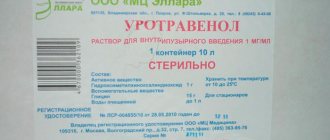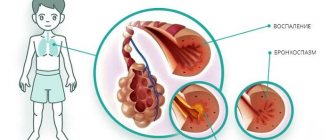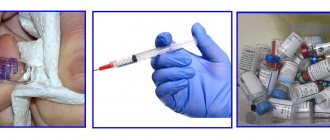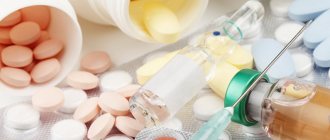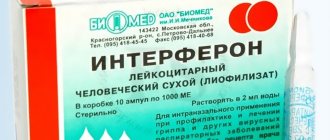Pharmacodynamics and pharmacokinetics
Pharmacodynamics
Albumin is a plasma replacement drug that is obtained by fractionating blood, plasma and serum of donors. Its administration replenishes the lack of plasma albumin (a source of protein), maintains oncotic pressure, increases plasma volume (in some patients this effect lasts for several hours) and blood pressure, and has detoxification properties. Available in the form of 5%, 10% and 20% solutions. After filling, the vials are pasteurized at 600 C for 10 hours to avoid transmission of serum hepatitis. A 5% solution is iso-oncotic plasma, and a 20% solution is hyper-oncotic.
Pharmacokinetics
T1/2 is 19 days. Elimination by intracellular pathway involving lysosomal proteases . In healthy individuals, 10% of the administered solution is removed from the bloodstream in the first 2 hours. Severely ill patients lose significant amounts of protein, so the rate of release is difficult to predict.
Composition, release form and analogues
The main active ingredient of the drug is the human protein albumin. The solution is obtained by fractionating blood plasma. It is a transparent liquid with a yellow or light brown tint.
Release form of the drug:
- 20% solution for infusion, 50 and 100 ml in glass bottles;
- 5% and 10% solution for infusion, 50,100, 200 and 400 ml in glass bottles;
- 5%, 10% and 20% solution for infusion, 10 and 20 ml in glass ampoules.
Bottles with Albumin solution are hermetically sealed with rubber stoppers and crimped with aluminum caps. There are 10 ampoules each and each bottle along with instructions is placed in cardboard boxes. An ampoule knife is additionally included in the package with ampoules, except in cases where the ampoules have a notch or a colored break ring.
When using the drug, it is necessary to take into account that Albumin solution of 20, 10 and 5% concentrations has different pharmacological effects.
Analogs or substitutes for the drug are: Zenalb-20, Zenalb-4.5, Plasbumin 20, Plasma and Uman Albumin.
Indications for use
- burns;
- shock;
- hypoalbuminemia against the background of nutritional dystrophy, glomerulonephritis , liver cirrhosis , purulent processes, ulcerative colitis and gastrointestinal tumors ;
- therapeutic plasmapheresis ;
- replenishment of bcc ;
- cerebral edema;
- during operations under artificial circulation;
- preoperative hemodilution .
Contraindications
- increased sensitivity;
- severe heart failure ;
- hypervolemia;
- pulmonary edema;
- arterial hypertension;
- severe anemia ;
- thrombosis;
- ongoing bleeding.
It is prescribed with caution during pregnancy (only if the potential benefit to the pregnant woman outweighs the risk to the fetus), renal and heart failure, and hemorrhagic diathesis .
Albumin, instructions for use (Method and dosage)
The solution is administered intravenously. A single dose is determined taking into account the severity of the patient's condition and depends on the volume of circulating blood, and not the level of protein in the plasma. For a 5% solution, a single dose is 300-500 ml, which is administered at a rate of up to 60 drops per minute. The 10% drug is administered at a rate of 40-50 drops per minute and its dose is 300 ml. For older people, the solution is administered even more slowly to avoid overloading the heart. For children, IV Albumin is prescribed at the rate of 3 ml per kg of weight.
The rate of administration of 20% of the drug is up to 40 drops per minute, 50 -100 -200 ml are administered once. When plasma is exchanged, the rate is higher. Since a 20% solution effectively increases osmotic pressure, during its administration there should be caution in terms of circulatory overload and the occurrence of overhydration . This solution can be diluted with saline solution.
The instructions for use of Albumin contain a warning that the infusion can be carried out if the solution in the bottle is transparent and the glass packaging is sealed. In case of dehydration, the drug should be administered after replenishing the body with fluid taken orally or parenterally. Before administration, the drug must be kept at room temperature and administered immediately after opening the bottle.
Human albumin, 20%, solution for infusion, 50 ml, 1 pc.
Allergic reactions/anaphylactic shock
Any suspicion of allergic or anaphylactic reactions requires immediate discontinuation of the drug. If shock develops, standard antishock therapy should be used.
Because this drug is made from human blood plasma, it may carry a risk of transmitting infectious agents, such as viruses and, theoretically, Creutzfeldt-Jakob disease. This also applies to unknown or new viruses and other pathogens.
The risk of pathogen transmission is reduced by screening plasma donors for possible past exposure to certain viruses, by testing for current infection with certain viral infections, and by inactivating and/or removing certain viruses. The measures taken are considered effective for enveloped viruses such as HIV, hepatitis B virus, hepatitis C virus, as well as for non-enveloped viruses such as hepatitis A virus and parvovirus B19. It is strongly recommended that each time Human Albumin is administered to a patient, the name and batch number of the drug are recorded in order to establish a connection between the patient and the batch of the drug.
Hemodynamics
Do not administer without careful monitoring of hemodynamic parameters, monitor for the development of symptoms of cardiac or respiratory failure, renal failure, or increased intracranial pressure.
Hypervolemia/hemodilution
Human albumin should be used with caution in conditions in which hypervolemia and its consequences or hemodilution may pose a particular risk to the patient. Examples of such conditions are: decompensated heart failure, hypertension, varicose veins, pulmonary edema, hemorrhagic diathesis, severe anemia, renal and postrenal failure. The rate of administration should be selected in accordance with the concentration of the solution and the hemodynamic parameters of the patient. Rapid administration may result in circulatory overload and pulmonary edema. At the first clinical signs of overload of the cardiovascular system (headache, shortness of breath, blockage of the jugular veins) or increased blood pressure, increased pressure in the central vein and pulmonary edema, administration of the drug should be stopped immediately.
Application in pediatric practice
The safety and effectiveness of human Albumin solution in pediatric patients has not been established, however, no additional risks of using this drug in children, in addition to the risks that exist when using it in adults, have not been identified.
Large volumes
When replacing relatively large volumes, it is necessary to monitor the parameters of the coagulation system and hematocrit level. It is necessary to ensure adequate replacement of other blood components (clotting factors, electrolytes, platelets and red blood cells). It is necessary to strictly monitor hemodynamic parameters.
Electrolyte status
When administering human Albumin, the patient's electrolyte status should be monitored, and the necessary measures should be taken to restore and maintain electrolyte balance.
Blood pressure
The increase in blood pressure after infusion of human Albumin necessitates careful monitoring of the patient after injury or after surgery in order to identify and treat damaged vessels that might not bleed at lower blood pressure.
Application, handling and disposal
Human Albumin solution should not be mixed with other drugs, incl. with whole blood and blood components, but may be used as a concomitant drug if medically appropriate.
Do not use if the solution becomes cloudy or the seal of the bottle is broken. Before use, preparations for parenteral administration should be visually inspected for the presence of mechanical inclusions and color changes, if the solution and container allow this. If leaks are detected, the drug must be thrown away.
There is a risk of hemolysis, with potentially fatal consequences, as well as a risk of acute renal failure when using sterile water for injection to dilute human albumin at concentrations of 20% or higher. Recommended solvents include 0.9% sodium chloride or 5% dextrose in water.
Impact on the ability to drive vehicles and operate machinery
There are no data on the effect of human Albumin on the ability to drive a car and work with other machines and mechanisms.
Analogs
Level 4 ATC code matches:
Perftoran
Gelofusin
Poliglyukin
Stabizol
Ceruloplasmin
Refortan
Hemodez
Reopoliglyukin
Plasbumin 20 , Albumin 20% , Alburex , Zenalb-20 , Postab solution .
Pharmacological action of Albumin
A plasma replacement agent that maintains blood oncotic pressure, replenishes plasma albumin deficiency and quickly increases circulating blood volume and blood pressure.
A 5% solution of the drug is isoncotic to plasma. Albumin solution 20% is hyperoncotic. The colloid-osmotic effect of such a solution exceeds the plasma effect by approximately four times. The duration of the results obtained may vary from patient to patient. In some of them, the increase in plasma volume persists for several hours.
In addition, the protein albumin performs a transport function, binding and transporting enzymes, hormones and drugs through the vascular bed.
Reviews
Amino acids that enter the body with food undergo transformations in the liver: some are used for the synthesis of purine nucleotides , uric acid , creatine , some undergo breakdown, and from a certain amount tissue proteins, hormones and enzymes are synthesized. Hepatocytes synthesize absolutely all albumins and globulins : 75–90% α-globulins and 50% β-globulins .
Albumin in the blood is a regulator osmotic pressure , and is also a transport protein that transports free fatty acids, hormones ( thyroxine and triiodothyronine ), unconjugated bilirubin , enzymes , and medications. The normal level of albumin in the blood is 40-50 g/l, and protein should not be present in the urine. Its appearance indicates pathology of the glomerular apparatus of the kidneys in arterial hypertension , diabetes mellitus , systemic lupus , congestive heart failure , adrenal tumors, nephropathy of pregnancy and kidney disease.
If albumin is elevated in the blood, what are the reasons for this? An increase in its level indicates blood thickening. This condition is observed if a person intensively loses fluid (vomiting, diarrhea , profuse sweating), and receives very little of it. However, its high concentration is not significant.
Albumin can be reduced due to pathological processes in the liver - with cirrhosis there is a sharp decrease in its synthesis. As its level in plasma falls, oncotic pressure and albumin enters the intercellular space - edema and ascites . A decrease in the level of this protein is observed with increased capillary permeability, protein loss in severe sepsis , burns, malignant neoplasms, fasting, thyrotoxicosis and nephrotic syndrome .
The drug Albumin is used for therapeutic purposes, what is it? This drug is obtained from human donor blood, not animals, and is used for hypodysproteinemia , BCC deficiency - since it has oncotic properties (retains water in the bloodstream and increases BCC ). It is prescribed for shock , burns, hypoalbuminemia in tumor diseases, severe purulent-inflammatory processes, and blood loss (in combination with blood and red blood cell transfusions). Due to the high price of the drug, it has recently been used only for severe hypoalbuminemia . In other cases, alternative drugs are modern synthetic colloidal plasma expanders . Albumin is administered intravenously, and since it is a foreign protein, a biological test is performed before administration.
Reviews about this drug are contradictory:
- “... Albumin raises the pressure even higher”;
- “... It took me 7 droppers. I tolerated it normally”;
- “... With ascites, mom was given drops of it. He does his job, but not quickly”;
- “...The introduction of albumin increases its level for 4-5 days, and then it falls again”;
- “... It was given to a child with low albumin. There was severe swelling and protein in the urine. The swelling went away, the weight was lost in kilograms.”
What other albumin preparations exist and what are the aspects of their use in medicine? Bovine serum albumin is a dry lyophilisate that is used for diagnostic purposes. Its production process is not expensive, so it is the most common reagent in biochemical research.
There is often a question on the Internet: “What is food black albumin and does it have anything to do with medicine? Should I take it myself and give it to children? Edible black albumin is made from cattle blood powder and is part of hematogen , an iron-containing preparation. This red blood cell concentrate is a source of iron. To improve the taste, condensed milk, ascorbic acid , sugar syrup, and molasses are added.
In fact, what is black food albumin - a panacea or self-comfort, a delicacy or a drug? Is it useful or fraught with danger? Considering the fact that hematogen is produced at pharmaceutical plants, you can be sure that the blood undergoes special treatment, and this eliminates the transmission of various infectious diseases to humans. It is sold as a medicine through the pharmacy chain, so it is not a delicacy, but a medicine. You need to give it to children and take it yourself in the dosage indicated in the instructions or by your doctor.
An overdose can cause vomiting and diarrhea , allergic reactions. The maximum amount is 50 g per day for adults and 25 g for children. With all this, we cannot have 100% confidence that the blood does not contain hormones, stimulants, or medications that were given to the animal. So it is impossible to establish the true nature of Albumin and whether it brings more benefit or harm.
- “... I didn’t like hematogen, and I didn’t like the taste of it. I’m indifferent to sweets”;
- “... During pregnancy I wanted it so much and ate 3 pieces a day”;
- “... I consider it useful and give it to the child, but in moderation!”
Egg white, which is often purchased from online stores, is an egg-scented powder obtained from the whites of chicken eggs. This is an easily digestible, concentrated protein that bodybuilders take as protein shakes or added to meals. It is part of a dietary supplement for people who intensively engage in sports to build muscle mass.
This protein is used in the food industry: making wines and cognacs, preparing confectionery, cakes, souffles, meringues, marshmallows, as well as in home cooking. High-quality raw materials do not contain salmonella and E. coli . In an airtight container and dry conditions, the powder can be stored for up to a year. It is sold only in 20 kg bags. Persons allergic to protein should not consume it. Constipation , flatulence may occur .
Side effects
Negative reactions when taking the drug develop very rarely. These include:
- Dyspnea;
- Tachycardia;
- Increased body temperature;
- Chills;
- Pain in the lumbar region;
- Reduced blood pressure;
- Allergic reactions in the form of urticaria.
If complications occur, the administration of Albumin should be stopped and, without removing the needle from the vein, cardiotonic, antihistamines and vasopressor drugs should be administered (if there are appropriate indications).
Albumin price, where to buy
You can buy Albumin in Moscow in many pharmacies. The price of Albumin 10% 100 ml ranges from 1317-1590 rubles, and the drug 20% 100 ml from 3099-4042 rubles. Egg albumin, used in the food industry, is produced in bags of 5-20 kg, and is also sold by weight in specialized stores.
- Online pharmacies in RussiaRussia
- Online pharmacies in UkraineUkraine
- Online pharmacies in KazakhstanKazakhstan
ZdravCity
- Albumin human solution for inf.
5% bottle 500ml, cardboard packOctapharma Pharmazeutika Produktions GmbH RUR 6,172 order - Albumin human solution for inf. 5% bottle 250ml, cardboard packOctapharma Pharmazeutika Produktions GmbH
RUB 3,100 order
- Albumin solution for inf. 20% 100ml JSC NPO Microgen
RUR 3,874 order
- Albumin solution for inf. 10% 100ml FSUE Microgen NPO FSUE
RUB 2014 order
Pharmacy Dialogue
- Albumin (vial 20% 100ml)Baxter Oncology
RUR 4,399 order
- Albumin (flask 20% 100ml) Microgen (ImBio N.-Novgorod)
RUR 3,808 order
- Albumin (vial 20% 100ml) Microgen Ufa (Immunopreparation)
RUB 3,847 order
- Albumin (vial 10% 100ml) Microgen N.-Novgorod (ImBio)
RUB 1,884 order
show more
Pharmacy24
- Hematovit with albumin and dried apricots 40 g TOV Vitapak, Dnipropetrovsk
9 UAH order - Albumin-Biopharma 20% 50 ml solution TOV "Biopharma Plasma" , Ukraine
981 UAH order
- Hematovit with albumin and coconut flakes 40g TOV Vitapak, Dnipropetrovsk
9 UAH order
- Albumin-Biopharma 10% 100ml solution for infusion TOV "Biopharma Plasma" , Ukraine
1044 UAH order
- Hematogenium classic with albumin 50g TOV "RIF", Ukraine
7 UAH order
PaniPharmacy
- Albumin infusion Albumin solution 20% 100ml Ukraine, Biopharma Plasma LLC
1810 UAH order
- Albumin infusion Albumin solution 20% 50ml Ukraine, Biopharma Plasma LLC
1245 UAH. order
- Albumin infusion Albumin solution 10% 100ml Ukraine, Biopharma Plasma LLC
1013 UAH. order
show more
